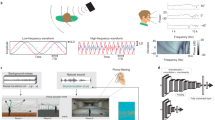Abstract
We present in this paper a connectionist model that extracts interaural intensity differences (IID) from head-related transfer functions (HRTF) in the form of spectral cues to localize broadband high-frequency auditory stimuli, in both azimuth and elevation. A novel discriminative matching measure (DMM) is defined and optimized to characterize matching this IID spectrum. The optimal DMM approach and a novel backpropagation-based fuzzy model of localization are shown to be capable of localizing sources in azimuth, using only spectral IID cues. The fuzzy neural network model is extended to include localization in elevation. The use of training data with additive noise provides robustness to input errors. Outputs are modeled as two-dimensional Gaussians that act as membership functions for the fuzzy sets of sound locations. Error back-propagation is used to train the network to correlate input patterns and the desired output patterns. The fuzzy outputs are used to estimate the location of the source by detecting Gaussians using the max-energy paradigm. The proposed model shows that HRTF-based spectral IID patterns can provide sufficient information for extracting localization cues using a connectionist paradigm. Successful recognition in the presence of additive noise in the inputs indicates that the computational framework of this model is robust to errors made in estimating the IID patterns. The localization errors for such noisy patterns at various elevations and azimuths are compared and found to be within limits of localization blurs observed in humans.
Similar content being viewed by others
References
Angell, J. C., and W. Fite. The monaural localization of sound.Psychol. Rev. 8:225–243, 1901.
Ben-Arie, J., and K.R. Rao. Non-orthogonal signal representations by Gaussians and Gabor functions.IEEE Trans. Circuits Syst. 42:402–413, 1995.
Blauert, J. Modeling of interaural time and intensity difference discrimination. In:Psychophysical, Physiological, and Behavioral Studies in Hearing edited by G. vanden Brink and F. Bilsen. Delft, The Netherlands: Delft University Press, 1980, pp. 421–424.
Bodreau, J., and C. Tsuchitani: Binaural interaction in the superior olive S-segment.J. Neurophysiol 21:422–454, 1968.
Colburn, H. S. and N. I. Durlach. Models of binaural interaction. In:Handbook of Perception IV: Hearing, edited by E. C. Carterette and M. P. Friedman. New York: Academic Press, 1978, pp. 467–515.
Duda, R. O. Estimating Azimuth and Elevation from the Interaural Intensity Difference. Technical Report no. 4. San Jose, CA: Department of Electrical Engineering, San Jose State University, September 1993, 57 pp.
Guinan, J., Jr., B. Norris, and S. Guinan. Single auditory units in the superior olivary complex. II. Locations of unit categories and tonotopic organization.Int. J. Neurosci 4: 147–166, 1972.
Haykin, S.Adaptive Filter Theory. Englewood Cliffs, NJ: Prentice-Hall, 1986, 590 pp.
Holmström, L., and P. Koistinen. Using additive noise in back-propagation training.IEEE Trans. Neural Networks 3:24–38, 1992.
Kosko, B.Neural Networks and Fuzzy Systems: A Dynamical Systems Approach to Machine Intelligence. Englewood Cliffs, NJ: Prentice-Hall, 1992, 449 pp.
Lyon, R. F. Computational models of binaural localization and separation.Proc. ICASSP, 3:1148–1151, 1983.
Lyon, R. F. An analog electronic cochlea.IEEE Trans. Acoustics Speech Signal Processing 36:1119–1134, 1988.
Makous, J. C., and J. C. Middlebrooks. Two-dimensional sound localization by human listeners.J. Acoust. Soc. Am. 87:2188–2199, 1990.
Middlebrooks, J. C., and D. M. Green. Sound localization by human listeners.Annu. Rev. Physiol. 42:135–59, 1991.
Musicant, A. D. and R. A. Butler. Influence of monaural spectral cues on binaural localization.J. Acoust. Soc. Am. 77:202–208, 1985.
Nandy, D., and J. Ben-Arie. A comparison of auditory localization models.Proceedings of the 12th ICPR, Jerusalem, Israel, October 1994, Vol. 3, pp. 123–127.
Neti, C., E. D. Young, and M. H. Schneider. Neural network models of sound localization based on directional filtering by the pinna.J. Acoust. Soc. Am. 92:3140–3156, 1992.
Plenge, G. On the difference between localization and lateralization.J. Acoust. Soc. Am. 56:944–951, 1953.
Rumelhart, D. E., G. E. Hinton, and R. J. Williams. Learning internal representations by error propagation. In:Parallel Distributed Processing: Explorations in the Microstructure of Cognition: Foundation vol. 1, edited by D. E. Rumelhart and J. L. McClelland. Cambridge: MIT Press, 1986, pp. 318–362.
Sachs, M. B., and P. J. Abbas. Rate versus level functions for the auditory-nerve fibers in cats: tone-burst stimuli.J. Acoust. Soc. Am. 56:1835–1847, 1974.
Shaw, E. A. G. Transformation of sound pressure level from the free field to the ear drum in the horizontal plane.J. Acoust. Soc. Am. 56:1848–1861, 1974.
Wenzel, E. M. Localization in virtual acoustic displaysPresence Teleoperators Virtual Environments 1:80–107, 1992.
Wightman, F. L., and D. J. Kistler. Headphone simulation of free-field listening. I. Stimulus synthesis.J. Acoust. Soc. Am. 85:858–867, 1989.
Yang, X., K. Wang, and S. A. Shamma. Auditory representations of acoustic signals.IEEE Trans. Information Theor. 38:824–839, 1992.
Yost, W. A., and D. W. Nielsen.Fundamentals of Hearing: An Introduction. New York: CBS College Publishing, 1985, 269 pp.
Zwislocki, J., and R. Feldman. Just noticeable differences in dichotic phase.J. Acoust. Soc. Am. 28:860–864, 1956.
Author information
Authors and Affiliations
Rights and permissions
About this article
Cite this article
Nandy, D., Ben-Arie, J. An auditory localization model based on high-frequency spectral cues. Ann Biomed Eng 24, 621–638 (1996). https://doi.org/10.1007/BF02684176
Received:
Revised:
Accepted:
Issue Date:
DOI: https://doi.org/10.1007/BF02684176




